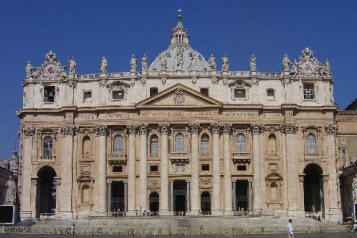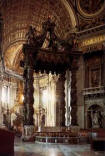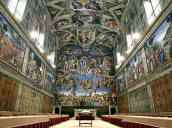|
Treasures of the Church- Holy Sites |
Basilica of
St. peter
by SCTJM
The apostle Saint Peter acme to
Rome around the year 50 and was martyred on the Vatican Hill
between the years 64 and 67. On his tomb Pope Anacletus built an
oratory which was replaced with a basilica by the emperor
Constantine.
The Basilica of Saint Peter, as we contemplate it now, is the fruit
of a laborious reconstruction of the former Basilica that the
emperor Constantine built around the year 320 A.D. It was
consecrated by Pope Silvester I on November 18, 326. Saint Peter is
the biggest Church in the entire world, measuring 192 meters long.
For about 12 centuries the Basilica functioned with basic
reparations until Pope Julius II deemed it an unsafe place and so
ordered a new basilica to be built. On April 18, 1506, the first
stone was placed for the construction of the new basilica. It needed
around 120 years for its completion and twelve architects, some of
whom included the famous Bramante, Michelangelo, Rafael, and
Maderno.
The former and new Basilica were built over the tomb of the first
apostle who was buried over the slopes of the Vatican hill, in an
area of cemeteries near the circle of the emperor Nero.
The large area of the copula built by Michelangelo is a dominant
feature of the skyline of the city of Rome, establishing an ideal
point of convergence. On the other hand, the basilica reminds us of
the simple tomb of Saint Peter, the rock over which Christ founded
his Church. The columns built by Bernini in the shape of open arms
as a sign of a warm welcome, highlight the idea of the Church as
Mother which in Christ makes diverse nations and peoples one
community of brethren.
To enter the Basilica there are five doors, two of which are open
for the pilgrims. The central door known as the “bronze door” was
part of the former Basilica and the rear left door is known as the
Door of Death. These two doors always remain closed. The rear right
door is the Holy Door which is opened only in Holy Years or Jubilee
Years. The door to the right of the central door is known as the
Door of the Sacraments and the door to the left of the central door
has been named as the Door of Good and Evil.
The Holy Door
The Holy Door is a symbol of the Jubilee. At the beginning of the
Holy Year it is opened by the Pope with a solemn celebration.
Pilgrims from all over the world pass through this door. The Holy
Door is the most meaningful symbol of the Holy Year. It is normally
sealed and it is opened only on jubilee occasions.
It seems that the idea of closing and opening the door only on these
extraordinary occasions is taken from the ancient Christian custom
that prohibited entry to the church of public penitents until they
had not completely fulfilled their penance.
The ancient ceremony of opening transmitted from generation to
generation since the year 1499, is rich in symbols and in meaning.
The tool used to open the door is not a key as one may imagine, but
rather it is a hammer. The banging that takes place in the ritual
and that is done directly by the Pope, reminds one of a door that is
difficult to knock down. Indeed, justice and mercy, highlighted by
the spirit of the Holy Year, are attained only by the strength of
prayer and repentance. In the same manner, in the words the Pope
pronounces meanwhile he is tumbling down the piece that covers the
door and in the responses the ritual requires of those present in
the celebration, one finds the meaning of this event which
officially opens the celebrations of the Jubilee: “This is the door
of the Lord,” the Pope states, and the faithful respond, “The just
will enter through it.”
Statue of Saint Peter and the Central Nave
As one enters Saint Peter’s Basilica, the first feeling one
experiences is amazement. The visitor is dominated by the grandeur
of the church; but this is a momentary sensation because the
largeness surrounding you leads you to participate in a much greater
reality and thus enter into a dimension of pure contemplation. Its
construction, fruit of the sublime art of many artists, gives
witness to the perennial faith of a Church founded over Christ, and
narrates the glory, power, strength, and beauty of God who is
present in time and embraces all those who believe in Him. The
apostle Peter, the first Pope, is the loyal witness of God made Man.
His bronze statue is the most sought item by millions of pilgrims
who come from all over the world to venerate the Saint and pray over
his tomb.
The statue’s right foot has been wore down by the kisses from the
faithful who still repeat to this day the ancient gesture of
devotion. The statue, credited to Arnolfo di Cambio (1245-1302),
represents Peter sitting and blessing as he extends in his hands the
keys which are a symbol of the authority given by Christ to govern
the Church.
Bernini’s Altar
 The
center of Saint Peter’s Basilica is the tomb of the apostle which is
covered by the Papal altar. Millions of pilgrims head towards this
area. It is here where the High Priest celebrates the solemn
liturgies. Also in this way, one visibly sees the continuity between
the first Pope and the current Pope, both of whom are
representatives of Jesus whom the Church makes present in the
history of the world. The Eucharist celebrated by the Pope on this
altar gives meaning to and continues salvation history in time.
Above the altar there is a large, bronze baldacchino made by Bernini
in 1626. The four huge columns of bronze, twisted and decorated with
olive leaves and bees support a draped canopy that seems to be moved
by the wind. The baldacchino which covers the altar and the tomb of
Saint Peter makes evident the idea of the tent which conserves,
protects, and adorns; it is also an explicit allusion to the
prologue of the Gospel of John (chapter 1, verse 14) which mentions
that the Word of God is made flesh and places his “tent” in the
midst of the community of people. The
center of Saint Peter’s Basilica is the tomb of the apostle which is
covered by the Papal altar. Millions of pilgrims head towards this
area. It is here where the High Priest celebrates the solemn
liturgies. Also in this way, one visibly sees the continuity between
the first Pope and the current Pope, both of whom are
representatives of Jesus whom the Church makes present in the
history of the world. The Eucharist celebrated by the Pope on this
altar gives meaning to and continues salvation history in time.
Above the altar there is a large, bronze baldacchino made by Bernini
in 1626. The four huge columns of bronze, twisted and decorated with
olive leaves and bees support a draped canopy that seems to be moved
by the wind. The baldacchino which covers the altar and the tomb of
Saint Peter makes evident the idea of the tent which conserves,
protects, and adorns; it is also an explicit allusion to the
prologue of the Gospel of John (chapter 1, verse 14) which mentions
that the Word of God is made flesh and places his “tent” in the
midst of the community of people.
In front of the Papal Altar, one finds the Confession. It is so
called because it was built over the tomb of he who confessed his
faith to the point of martyrdom. Here 99 lights are lit daily to
venerate Saint Peter.
Tomb of Saint Peter
The many episodes that tradition attributes to Saint Peter during
his apostolate in Rome, as well as the incredible flourishing of
legends and the numerous churches named in his honor, prove the
continued and ever growing veneration from Christians of the first
Pope and the most human and kind presence of this fisherman from
Bethsaida of Galilee. For many centuries it has been considered that
the humble tomb, placed over the slope of the Vatican hill and on
which the impressive Basilica was built, is the tomb of the Prince
of the Apostles.
In recent times and by initiative of Pope Pius XII, between the
years 1940-1957, many meticulous excavations in the Vatican
necropolis have been done. The surprising archeological findings
that emerged contributed to the confirmation of the authenticity of
Saint Peter’s tomb.
There where Peter died on the Cross, “equaling the Passion of
Christ” (Tertullian), has remained throughout the centuries as the
immovable “rock” over which the Son of God has founded for all
eternity his Church (cf. Matthew 16, 13-19).
The Chair
Next to the apse of Saint Peter emerges the throne of the Chair that
Bernini completed between the years 1658 and 1666. The See of the
bishops, and in a particular way that of the Pope, are normally
designated as cathedrals to highlight the duty of teaching, typical
of the episcopal service and most specially of the Pope. According
to legend, the Episcopal Chair of Peter is found in that majestic
throne, precisely the seat from where the apostle, already advanced
in age and fatigue, taught the early Christians.
The bronze throne is consequently a large reliquary in the shape of
a monstrance supported by four Doctors of the Church – Saints
Ambrose and Augustine representing the Latin Church and Athanasius
and John Chrysostom the Greek Church. Since antiquity, the Church
has called Doctors those men and women who have contributed in a
decisive way to studying in depth the message of Revelation. Bernini
has put them at the foot of the Cathedra of the Pope to the center
of which Bernini placed the Dove, symbol of the Third Person of the
Trinity (Holy Spirit), makes evident that the Pope, in his ministry
of Teacher of the entire Church, is illuminated and inspired by God
himself.
Pieta of Michelangelo
It is the first of the four “pietas” that Michelangelo made and the
only one completely finished and different from the other works of
the artist in that this one is signed. Michelangelo was only 24
years old at the time. The statue causes astonishment by the
precision of the shapes and by the composure of the beauty of the
faces and bodies. The originality of the sculpture is evident. In
representing the Virgin Mary with Christ dead in her arms, artists
would often depict her beaten by pain and desperation. Michelangelo,
on the other hand, wanted to give us a different vision of human
pain: the celestial countenance of the Mother who holds the lifeless
body of Jesus reveals a sweetness without comparison, a serene
acceptance of pain. It is said that when Michelangelo was
reproached for having sculpted the Virgin Mary to look too young
when in reality she should have been at least 45 or 50 years old, he
responded that he had done so on purpose because the action of time
could not ruin the face of the Virgin Mary which is a symbol of
perennial youth.
Vatican Grottos
The Vatican Grottos extend underneath the Basilica of Saint Peter
and the surrounding areas. In the grottos, sarcophagi of the former
Basilica and funeral monuments that date back to the Roman period
are found and safeguarded. One may also find chapels and tombs of
various saints and popes.
Vatican Museums
The history of the Vatican collections begins under the pontificate
of Julius II (1503-1513) and continues, modeling itself by the
culture and taste of the time. It was born in the Renaissance as an
exclusive collection, almost particular, of master works of ancient
sculptures, and it developed with the decoration of palaces and
Vatican gardens. Under the rigor of the counterreformation it was
put almost totally to the side. It reflourished in the 18th century
with the intention of providing scholarly documentation, first in
the library field and later like a great public collection, made for
the benefit of the culture. It housed so many ancient works of art
which were bought with the purpose of saving them from being
exported like the others that archaeology had dug up. In the 19th
century, it was expanded with new delineate his contribution to the
Pontifical Magisterium. The crown of rays,
themes of interest, such as Etruscan and Egyptian works, and even
with ancient paintings of “natives” and relics of paleochristian
art. In the end, it reached its greatest splendor in the 20th
century, opening itself up to ethnology and contemporary art.
Sistine Chapel
 The
Chapel was built at the will of Sixtus IV between 1475 and 1483 who
also named the chapel. It was destined to be the chapel of the
Palace, but it needed to represent at the same time a type of fort.
In the chapel there have been and continue to have the most
important ceremonies with the presence of the Pope: it is here where
the Conclave takes place, the meeting of Cardinals when the Pope
dies so that they elect the Pope’s successor. The
Chapel was built at the will of Sixtus IV between 1475 and 1483 who
also named the chapel. It was destined to be the chapel of the
Palace, but it needed to represent at the same time a type of fort.
In the chapel there have been and continue to have the most
important ceremonies with the presence of the Pope: it is here where
the Conclave takes place, the meeting of Cardinals when the Pope
dies so that they elect the Pope’s successor.
The Sistine Chapel represents one of the most outstanding monuments
and one of the most beautiful examples of Italian art. It is known
for its frescos of Michelangelo, but many frescos of famous artists
of the time are also found. Many of the landscapes and moments of
Sacred Scripture as well as the statues of prophets and apostles are
also found there.
This page is the work of the Servants of the Pierced Hearts of Jesus and
Mary
Copyright © 2006- SCTJM
|